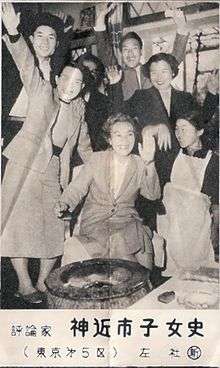Ichiko Kamichika
Ichiko Kamichika (神近 市子, Kamichika Ichiko) (June 6, 1888 – August 1, 1981) was a journalist, feminist, writer, translator, and critic. Her birth name was Ichi Kamichika and her pen name was Ei, Yo, or Ou Sakaki(榊 纓). After World War II, Kamichika served in the Japanese House of Representatives as a member of the Social Democratic Party.
Ichiko Kamichika | |
|---|---|
 | |
| Member of the House of Representatives | |
| In office 1953–1960 | |
| Constituency | Tokyo 5th district |
| Personal details | |
| Born | June 6, 1888 Nagasaki, Japan |
| Died | August 1, 1981 Tokyo |
Early life
Kamichika was born in what is now Saza, Nagasaki on June 6, 1888. She studied at Tsuda University, where she became affiliated with the Bluestocking society. After graduation she became a teacher at the Aomori Prefectural School for Girls, until she was asked to leave when her connection to the Bluestockings was discovered.[1] She began writing for the Tokyo Nichi Nichi Shimbun in 1914.[2]
Kamichika also met Ōsugi Sakae in 1914. In 1915, after they grew close enough that Ōsugi would stay at Kamichika's house over the weekend when he visited Tokyo to teach French classes. They began having an affair. Ōsugi was married at the time. In 1916 he also started a relationship with Itō Noe. The three women had a tense relationship, which culminated in November 1916, when Kamichika stabbed Ōsugi in an incident that was later called the Hayama Hikage Chaya scandal, after the teahouse in Hayama, Kanagawa where the incident took place. She was sentenced to 4 years in prison, but after appealing she only served 2.[1][3]
After Kamichika was released from prison in 1919, she wrote for the Nyonin Geijutsu. In 1920, she married Atsushi Suzuki and had three children. She and Suzuki published the Fujin Bungei in 1935. It was a literary journal that featured women writers and questioned Japan's increasing nationalism just before World War II broke out.[4]
Post-war

In 1947, after the war ended, Kamichika became active in political organizations and ran for office. While she wasn't elected that year, she was elected to the House of Representatives during the 1953 Japanese general election, representing Tokyo's 5th district. She was a member of the Leftist Socialist Party of Japan, then the Social Democratic Party. She lost her seat during the 1960 election, but regained it during the next term. During her time in office, she worked to pass the Prostitution Prevention Law.[5] She retired in 1969.[6]
In 1970, Kamichika tried to sue Yoshishige Yoshida for making a film called Eros + Massacre, which included a scene based on the Hayama Hikage Chaya incident. Instead, Yoshida changed the name of her character in the film to Masaoka Itsuko.[7][8]
Kamichika died on August 1, 1981. She wrote and translated many books throughout her life.
Selected bibliography
- Kamichika, Ichiko (1917). 引かれものの唄. 法木書店.
- Kamichika, Ichiko (1930). 現代婦人讀本 [A modern woman's reader]. 天人社.
- Kamichika, Ichiko (1933). 性問題の批判と解決. 東京書房.
- Kamichika, Ichiko (1948). 結婚について [On marriage]. 企画社.
- Kamichika, Ichiko (1951). 女性思想史 [The history of female thought]. 三元社.
- Kamichika, Ichiko (1972). 神近市子自伝 わが愛わが闘い [Autobiography of Ichiko Kamichika: my love and my battles]. Kodansha.
References
- 1946-, Stanley, Thomas A. (1982). Ōsugi Sakae, anarchist in Taishō Japan : the creativity of the ego. Paul Avrich Collection (Library of Congress). Cambridge, Mass.: Council on East Asian Studies, Harvard University. ISBN 067464493X. OCLC 7736889.CS1 maint: numeric names: authors list (link)
- "Kamichika, Ichiko | Portraits of Modern Japanese Historical Figures". www.ndl.go.jp. Retrieved 2019-03-14.
- Large, Stephen "The Romance of Revolution in Japanese Anarchism and Communism during the Taishō Period" pages 441–469 from Modern Asian Studies, Volume 11, No. 3, 1977.
- Coutts, Angela (May 2013). "Aftermath: Fujin Bungei and Radical Women's Fiction after the Downfall of the Proletarian Literature Movement in Japan". Japanese Studies. 33 (1): 1–17. doi:10.1080/10371397.2013.778390. ISSN 1037-1397. S2CID 143545973.
- Otto, Elizabeth; Rocco, Vanessa (2011). The New Woman International: Representations in Photography and Film from the 1870s through the 1960s. Digitalculturebooks. doi:10.3998/dcbooks.9475509.0001.001. ISBN 978-0-472-07104-3.
- "Prominent People of Minato City (Ichiko Kamichika)". www.lib.city.minato.tokyo.jp. Retrieved 2019-03-14.
- David, Desser (1988). Eros plus massacre : an introduction to the Japanese new wave cinema. Bloomington: Indiana University Press. ISBN 0253204690. OCLC 16351617.
- I., McDonald, Keiko (1983). Cinema East : a critical study of major Japanese films. Rutherford [N.J.]: Fairleigh Dickinson University Press. ISBN 0838630944. OCLC 8845903.